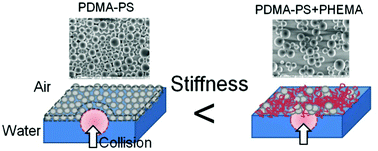Physical properties of mixed Langmuir monolayers of polystyrene particles with poly(N,N-dimethylaminoethylmethacrylate) hairs and a poly(2-hydroxyethyl methacrylate) polymer at an air/water interface
Abstract
The effect of adding a poly(2-hydroxyethyl methacrylate) (PHEMA) polymer to a Langmuir monolayer of polystyrene particles carrying poly(N,N-dimethylaminoethylmethacrylate) hair (PDMA-PS particles) at air/water interfaces on the physical properties of the monolayer was studied. The addition of PHEMA to a PDMA-PS particle monolayer at an air/water interface gave a polymer-like monolayer at low surface pressures and a particle-like monolayer at high surface pressures. The PDMA-PS particles formed small aggregates that were dispersed throughout the PHEMA monolayer at low surface pressures, a result suggesting that the particles were trapped in the PHEMA network. Monolayers of closely packed particles were observed at higher surface pressures, suggesting that PHEMA was squeezed-out at higher surface pressures. The stiffness of the mixed monolayer was independent of the surface pressure, but increased as the ratio of PHEMA in the mixed monolayer increased. This increased stiffness was explained by the immobilization of the PDMA-PS particles by PHEMA.



 Please wait while we load your content...
Please wait while we load your content...